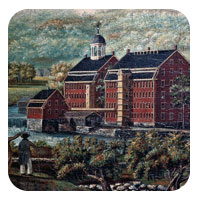The Tariff
How active should the government be in times of economic crisis? Does this question sound familiar?
It probably does given the deep recession in the United States (and much of the world) over the past few years. This question has been at the heart of many debates throughout American history. How did they answer that question in the early 1800s?
The industrial revolution began in Great Britain in the 1700s, when English textile producers developed machines to increase productivity. Samuel Slater, an apprentice in an English spinning mill, brought the knowledge of this British technology to the United States in 1789.
 |
Learn more about Slater's role in early American industrialization. |
In the decades that followed, an American textile industry developed in New England. By necessity, American manufacturing grew during the embargos on British imports before and during the War of 1812. Textile production in New England, albeit primitive by British standards, expanded especially rapidly. With no foreign competition, American companies could keep prices high.


The end of the war changed things. British manufacturers, their warehouses full of products, eagerly set out to conquer the U.S. market. They cut their prices even below cost in an effort to bankrupt their American competitors. U.S. political leaders, even Alexander Hamilton's opponents, recognized the economic benefits of manufacturing and resolved to defend the nation's manufacturers against foreign imports.
Though the foreign imports, including woolen and cotton goods, continued to sell in American markets, the tariff allowed New England textile manufacturers to eventually dominate the market. Protectionism received wide support from Americans in the years following the war.